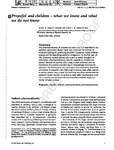Propofol and children – what we know and what we do not know
| dc.contributor.author | Rigby‐Jones, AE | |
| dc.contributor.author | Sneyd, JR | |
| dc.date.accessioned | 2012-11-09T22:01:48Z | |
| dc.date.accessioned | 2013-05-20T16:02:23Z | |
| dc.date.available | 2012-11-09T22:01:48Z | |
| dc.date.available | 2013-05-20T16:02:23Z | |
| dc.date.issued | 2011-03 | |
| dc.identifier.issn | 1155-5645 | |
| dc.identifier.issn | 1460-9592 | |
| dc.identifier.uri | http://hdl.handle.net/10026.1/1467 | |
| dc.description.abstract |
<jats:title>Summary</jats:title><jats:p>The pharmacokinetics of propofol are relatively well described in the pediatric population. Recent work has confirmed the validity of allometric scaling for predicting propofol disposition across different species and for describing pediatric ontogenesis. In the first year of life, allometric models require adjustment to reflect ontogeny of maturation. Pharmacodynamic data for propofol in children are scarcer, because of practical difficulties in data collection and the limitations of currently available depth of anesthesia monitors for pediatric use. Hence, questions relating to the comparative sensitivity of children to propofol, and differences in time to peak effect relative to adults, remain unanswered. <jats:italic>K</jats:italic><jats:sub>eo</jats:sub> half‐lives have been determined for pediatric kinetic models using time to peak effect techniques but are not currently incorporated into commercially available target‐controlled infusion pumps.</jats:p> | |
| dc.format.extent | 247-254 | |
| dc.format.medium | Print-Electronic | |
| dc.language | en | |
| dc.language.iso | eng | |
| dc.publisher | Wiley | |
| dc.relation.replaces | http://hdl.handle.net/10026.1/1215 | |
| dc.relation.replaces | 10026.1/1215 | |
| dc.subject | propofol | |
| dc.subject | children | |
| dc.subject | pharmacokinetics | |
| dc.subject | pharmacodynamics | |
| dc.title | Propofol and children – what we know and what we do not know | |
| dc.type | journal-article | |
| dc.type | Review | |
| plymouth.author-url | https://www.ncbi.nlm.nih.gov/pubmed/21083787 | |
| plymouth.issue | 3 | |
| plymouth.volume | 21 | |
| plymouth.publication-status | Published | |
| plymouth.journal | Pediatric Anesthesia | |
| dc.identifier.doi | 10.1111/j.1460-9592.2010.03454.x | |
| plymouth.organisational-group | /Plymouth | |
| plymouth.organisational-group | /Plymouth/Faculty of Health | |
| plymouth.organisational-group | /Plymouth/Faculty of Health/Peninsula Medical School | |
| plymouth.organisational-group | /Plymouth/Research Groups | |
| plymouth.organisational-group | /Plymouth/Research Groups/Plymouth Institute of Health and Care Research (PIHR) | |
| plymouth.organisational-group | /Plymouth/Users by role | |
| plymouth.organisational-group | /Plymouth/Users by role/Academics | |
| dc.publisher.place | France | |
| dc.identifier.eissn | 1460-9592 | |
| dc.rights.embargoperiod | Not known | |
| rioxxterms.versionofrecord | 10.1111/j.1460-9592.2010.03454.x | |
| rioxxterms.licenseref.uri | http://www.rioxx.net/licenses/all-rights-reserved | |
| rioxxterms.type | Journal Article/Review |


